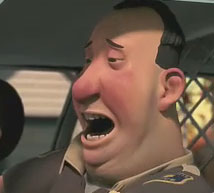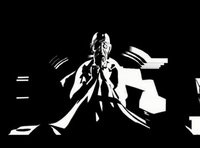Roto, Motion Capture, and the movies that result.
I guess I should start this off as a point of discussion because a few newer films have been added to this issue and am wondering what everyone else thinks of this. Here's my two cents.
Seems to me lately that there's as much money going into 3D animated films such as Cars and Over the Hedge as there are alternative forms of filmmaking, such as Rotoscoping and live action motion capture to achieve a graphic, stylized, or 3d-animated look. We saw it on the Polar Express (for better or for worse). Of course, Bob Zemeckis, the animator's former best friend, is bent on pushing motion capture as the future method to created Computer generated films, requiring smaller casts and supposedly fewer animators to complete a feature-length project, and purportedly captures a 'real human performance' - according to the producer of Polar Express (don't remember his name, haha). Anyways, here's the successor to Polar Express, Monster House. What strikes me about this movie is that the only element that needed to be a cgi element was the house itself - and truth be told, the budget would have been much less had they just shot actors and spent the special effects budget on blending the cgi element with live action. Of course, producers see cg animation as the 'in-thing' so therefore kids, who aren't supposed to know the difference, see it as the same. All I know is that the cost of the Polar Express was much higher than that of, say, Cars, because of the expenditures related to futhering the technology of the motion capture devices, which, in my opinion, have not been perfected as of yet, and will probably need similar future investments to put it on par with some of the real animation that's out there. Either way, check out the expression on that guy's face - I can't tell what it's supposed to emote (sadness? unconfortable-ness? weirdness?) but it's badass nonetheless. Go motion capture.
Of course, Bob Zemeckis, the animator's former best friend, is bent on pushing motion capture as the future method to created Computer generated films, requiring smaller casts and supposedly fewer animators to complete a feature-length project, and purportedly captures a 'real human performance' - according to the producer of Polar Express (don't remember his name, haha). Anyways, here's the successor to Polar Express, Monster House. What strikes me about this movie is that the only element that needed to be a cgi element was the house itself - and truth be told, the budget would have been much less had they just shot actors and spent the special effects budget on blending the cgi element with live action. Of course, producers see cg animation as the 'in-thing' so therefore kids, who aren't supposed to know the difference, see it as the same. All I know is that the cost of the Polar Express was much higher than that of, say, Cars, because of the expenditures related to futhering the technology of the motion capture devices, which, in my opinion, have not been perfected as of yet, and will probably need similar future investments to put it on par with some of the real animation that's out there. Either way, check out the expression on that guy's face - I can't tell what it's supposed to emote (sadness? unconfortable-ness? weirdness?) but it's badass nonetheless. Go motion capture. This brings up another method that people are using called Rotoscoping, another way of achieving a 'sort-of-animated-sort-of-drawn' look for a film. Richard Linklater's second attempt at this looks to me at least better than the first, since the subject matter could benefit more from the technique, but rotoscoping is a painfully arduous process of painting literally every frame exactly like the live action reference and is no fun for person who actually has to do it. Another thing about the method that Linklater is using is the fact that the paint seems to float around someone's face when they aren't actually moving or moving only a little, such as in the scene with the screencap above, where the reaction is actually confused to the viewer because they are looking at the extraneous movement of his cheeks instead of his eyes. (Check out the doctor on the left's eyes right after that too - he totally goes cross-eyed/lazy-eyed). Trailer here.
This brings up another method that people are using called Rotoscoping, another way of achieving a 'sort-of-animated-sort-of-drawn' look for a film. Richard Linklater's second attempt at this looks to me at least better than the first, since the subject matter could benefit more from the technique, but rotoscoping is a painfully arduous process of painting literally every frame exactly like the live action reference and is no fun for person who actually has to do it. Another thing about the method that Linklater is using is the fact that the paint seems to float around someone's face when they aren't actually moving or moving only a little, such as in the scene with the screencap above, where the reaction is actually confused to the viewer because they are looking at the extraneous movement of his cheeks instead of his eyes. (Check out the doctor on the left's eyes right after that too - he totally goes cross-eyed/lazy-eyed). Trailer here. Then there's Pathé dans Paris, whose film Renaissance got the big prize at the Annecy film festival this year. It uses live action motion capture as well and capture a sort-of-sin-city-look. Check out trailer 1 and trailer 2.
Then there's Pathé dans Paris, whose film Renaissance got the big prize at the Annecy film festival this year. It uses live action motion capture as well and capture a sort-of-sin-city-look. Check out trailer 1 and trailer 2. And while you're at it check out this short film with a similar style based on Edgar Allan Poe's Tell-Tale Heart.
And while you're at it check out this short film with a similar style based on Edgar Allan Poe's Tell-Tale Heart.
I think what bugs me the most is when people say that movies like this have 'really nice animation but the stories are not so good' - especially with the fact that it's not really animation that they're doing, and without a story, it's just a piece of eye-candy. With Waking Life, I can't see that as being a notable film without its style aiding it, and the Polar Express itself is a rather ho-hum adaptation to a good short story. I think the common denominator with these films is that their style is more of a gimmick to draw viewers rather than a medium chosen to tell a story. I realise there's a pioneering spirit out there in terms of pushing visuals, but if you want the visuals to really sing, make sure it moves as well as the style that supports it - and I really think that the movement is the sole thing missing from interesting styles like that in Renaissance. So the real question is, why don't 2d and 3d animators do something with interesting styles and stories of their own? I've definetly heard the point being raised that with 3d animation, the designers are no longer limited to considering what animators can draw consistently, so all sorts of new options have opened up (for instance, no one would want to animated a character with stripes or patterns, among other things), and 3D allows for that.
Your comments?






3 comments:
It struck me as pretty stupid and ignorant that you expect mo-cap to be cheaper, like you say. First you gotta pay the actors to move, actors to speak, then we need animators to "clean up" the movement. So frankly, why bother really?Might as well make a 2d/live-action/ CG feature and be done with it
I think the rotoscoped animation of "A Scanner Darkly" is appropriate to this specific film; it creates a duality in the characters and the audience. This is the whole subject of the film, and it's a good film.
In "Waking Life" I thought the animation would have been better if it had been animated in a traditional and more "cartoony" look. Then we would have had an intelligent animated film with potentially exciting graphics.
I don't see the possibilities in motion capture other than to cheat animation. Why do it?
Steph - of course I agree!
Hey Mike - thanks for the linkage! I agree that A Scanner Darkly is a much more appropriate film for the medium - especially since it's plot is so intertwined with the need to have visuals that would be difficult to meld if it was just a live action film with cgi effects.
As for motion capture - it's purely a method to attempt to downsize the cost of animated features by making less people have to actually work on the end product - or at least is being developed so one day it can be as such. I definetly see it as the enemy!
Post a Comment